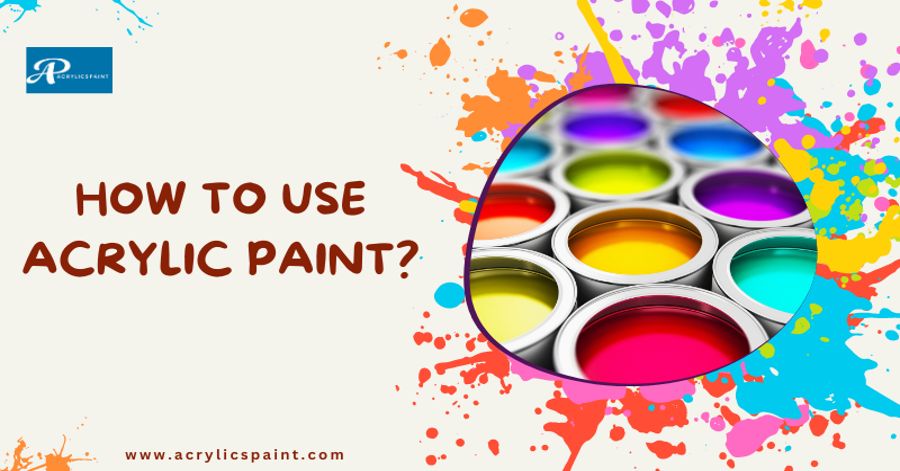How to use acrylic paint? – Are you eager to dive into the colorful world of acrylic painting but need help figuring out where to start? Acrylic paint is a versatile and vibrant medium that offers endless possibilities for artistic expression. Acrylics have a wide range of applications.
Artists have many options to apply these versatile paints. They can brush them on, pour them, spray them, or use them directly from the tube. With these paints, artists can create various effects – from bold impasto brushstrokes to delicate layers of transparent glazes.
Additionally, they lend themselves well to various techniques, including stenciling, fabric painting, marbling, and airbrushing. Acrylic paints can create surfaces and textures by blending different materials. This guide will provide the knowledge and techniques you need to create stunning works of art with acrylic paint.
What is Acrylic Paint? How to Use Acrylic Paint?
Acrylic paint is a fast-drying water-based paint made from pigment suspended in acrylic polymer emulsion. Artists can adapt and use it in multiple layers to meet different artistic preferences and needs.
Water-based and oil-based paints
Two common types of paints, water-based and oil-based, offer water resistance. For example, you can thin or wash acrylics and watercolors with water because they dissolve in water. Oil-based paints require mineral spirits or paint thinner to thin or remove water.
Heavy Body Acrylic Paint
This type of paint has a thick, buttery consistency that retains brushstrokes and is ideal for impasto techniques.
Soft Body Acrylic Paint
Soft body acrylic paint has a creamy consistency like oil paint, which makes it ideal for blending and glazing techniques.
Terms Used In Acrylic Paint
Pigments
Pigments are tiny, insoluble particles that serve as the raw material that gives paint its color. We mix these particles with a medium to create vibrant hues in acrylic paint.
Hue
Hue refers to the color itself, independent of its value (lightness or darkness), intensity (saturation), or undertones. Understanding hue allows artists to identify and mix colors accurately.
Saturation
Saturation measures the degree of a color’s brilliance or dullness, regardless of its hue. Highly saturated colors appear vivid and intense, while cool-tone colors are muted.
Tonal Value
Tonal value refers to how light or dark a color is. Artists must master tonal value to create depth and dimension by accurately depicting light and shadow.
Medium
The medium is the transparent body of the paint without pigment added. It extends paint, creates translucent effects, or is a final coat. Artists use paint mediums for image transfer or mixed media work, adding colors to their acrylic painting arsenal.
Gesso
Gesso is a primer to prepare surfaces for painting in acrylic or oil. It provides a smooth and stable foundation to which paint can adhere, ensuring better adhesion and longevity of the artwork.
Mass Tone vs. Under Tone
- Mass Tone: Mass-tone refers to applying color thickly and directly from the tube. It shows the color’s full intensity; artists often use it for bold, opaque applications.
- Under Tone: Undertone is a thin or diluted color applied thinly or in an acrylic medium or water. This technique increases transparency, allowing the undercolor to shine through and enhancing the vibrancy of the final color.
Paint Supplies
Before you begin painting, make sure you have the following supplies:
- Acrylic paint in different colours
- Brushes of various sizes and shapes
- Canvas or canvas paper for painting
- The palette for mixing colors
- Water for cleaning brushes and thinning paint
- Gesso for priming surfaces
- Mica powder for adding shimmer and texture to your paintings (optional)
Painting Techniques and Tips
You can start by following basic painting techniques to make your art.
1:Layering
Start with lighter colors and gradually build layers with darker shades to create depth and dimension.
2:Blending
Use a dry brush or a damp sponge to blend colors seamlessly on the canvas.
3:Dry Brushing
Apply a small amount of paint to a dry brush and lightly drag it across the surface for a textured effect.
4:Splattering
Dip a stiff brush or toothbrush into thinned paint and flick it onto the canvas for a dynamic and spontaneous look.
5:Shading with Acrylic Paint
Mix a darker color with a small amount of black or a complementary color to shade with acrylic paint. Apply the shaded color to the areas you want to appear darker, then blend it out using a dry brush or sponge for a smooth transition.
6:Sealing Acrylic Paint for Outdoor Use
To protect your acrylic paintings from the elements, apply a clear sealer or varnish after the paint has dried completely. Choose a product specifically designed for outdoor use to ensure longevity and durability.
7:Use Mica Powder in Acrylic Paint
Mix mica powder with acrylic paint to add shimmer and sparkle to your artwork. Mix the desired amount of mica powder into your acrylic paint until well combined, then apply it to the canvas as usual.
8:Using Gesso for Acrylic Painting
Gesso is a primer used to prepare painting surfaces for acrylic paint. Apply a thin layer of gesso to your canvas or canvas paper and allow it to dry completely before painting. Gesso provides a smooth and stable surface to which acrylic paint can adhere, allowing for better adhesion and longevity of your artwork.
Acrylic Painting Ideas
Abstract Acrylic Painting Techniques
Experiment with abstract acrylic techniques such as drip painting, palette knife painting, or tools like sponges or credit cards to create unique textures and patterns.
Beginner-Friendly Acrylic Painting Ideas
- Paint a simple landscape or still life using basic shapes and colors.
- Create a colorful abstract painting using bold brushstrokes and vibrant hues.
- Try using a reference photo as a guide to paint a portrait or a pet.
Remember to wash the brushes and tools with soap and water after painting. Immersing the jar in hot water loosens stuck lids by softening the dried paint film on the threads.
Conclusion
With its vibrant colors and endless possibilities, acrylic paint is the perfect medium for creating and expressing yourself artistically. Whether a beginner or an experienced painter, the key is to experiment, practice, and have fun with your artwork. So grab your brushes, pick up some acrylic paint, and let your imagination run wild!













